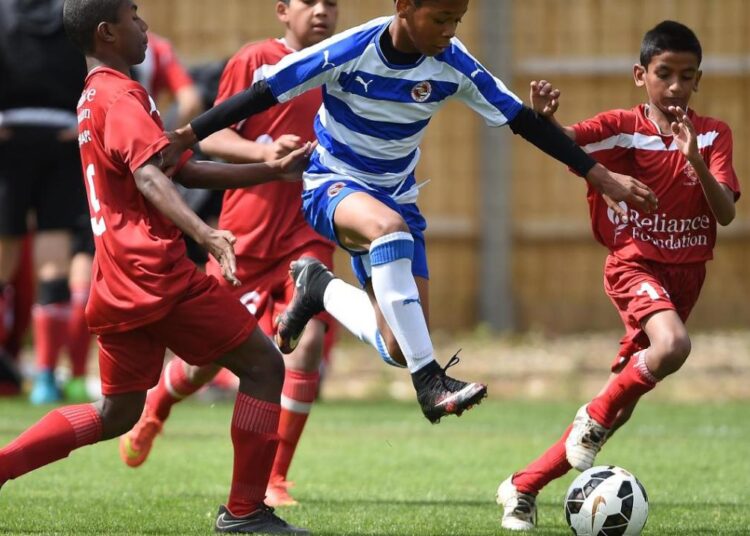The landscape of professional sports is a dynamic tapestry woven with tales of dedication, triumph, and the relentless pursuit of excellence. At the heart of this vibrant world lies the continuous emergence of youth talent, the lifeblood that keeps the competitive spirit alive and propels disciplines to new heights. Identifying, developing, and nurturing these young prodigies is a multifaceted challenge, demanding a holistic approach that extends far beyond mere physical training. This comprehensive article delves into the intricate processes and innovative strategies employed globally to cultivate the next generation of sporting superstars. We’ll explore the critical factors that contribute to their rise, the environments that foster their growth, and the delicate balance required to ensure both immediate success and long-term well-being.
Early Identification and Specialization

The journey of a future sports star often begins with early identification, but this process has evolved significantly. It’s less about spotting raw physical prowess and more about recognizing inherent potential and a genuine passion for the sport.
A. Multi-Sport Participation vs. Early Specialization
One of the most debated topics in youth sports development is the optimal timing for specialization.
- Benefits of Multi-Sport Participation:
- Broader Skill Development: Engaging in various sports develops a wider range of motor skills, coordination, and athletic intelligence. A basketball player who also plays soccer might develop better footwork and spatial awareness.
- Reduced Risk of Overuse Injuries: Specializing too early can lead to repetitive stress injuries due to the constant strain on the same muscle groups and joints. Multi-sport athletes distribute this stress more evenly.
- Reduced Burnout: The mental and emotional demands of early specialization can lead to burnout. Exposure to different sports keeps the activity fresh and enjoyable, fostering a love for movement rather than just a single sport.
- Enhanced Decision-Making: Different sports present unique tactical challenges, improving an athlete’s ability to analyze situations and make quick decisions.
- Arguments for Early Specialization (in specific contexts):
- Skill Acquisition in Technical Sports: Sports like gymnastics, figure skating, or swimming often require thousands of hours of highly specific practice to master complex motor patterns at a young age. Delaying specialization too long in these disciplines can hinder elite progression.
- Competitive Pathways: Some sports have highly structured competitive pathways that necessitate early commitment to progress through age-group ranks and gain exposure.
- Passion and Aptitude: If a child shows exceptional passion and aptitude for a particular sport, and expresses a strong desire to focus on it, responsible specialization with careful monitoring can be considered.
The modern consensus leans towards “early engagement but late specialization” for most team sports and many individual sports, allowing athletes to build a broad athletic base before committing to a single discipline.
B. Talent Identification Methodologies
Beyond raw athletic ability, talent identification now incorporates a wider range of indicators.
- Physical Attributes: Height, speed, strength, agility, and endurance are foundational, but their potential for development is often more important than current levels.
- Technical Skills: Proficiency in sport-specific movements, ball handling, shooting, passing, etc., assessed relative to age and developmental stage.
- Tactical Awareness: The ability to read the game, understand spatial relationships, make intelligent decisions, and adapt to changing situations. This is a crucial, often overlooked aspect of early talent.
- Psychological Characteristics:
- Intrinsic Motivation: A genuine love for the sport and a desire to improve, not just to win.
- Resilience and Grit: The ability to bounce back from setbacks, persevere through challenges, and maintain effort.
- Coachability: Openness to feedback and a willingness to learn and adapt.
- Competitive Drive: A healthy desire to compete and perform under pressure.
- Self-Regulation: The ability to manage emotions, focus attention, and maintain discipline.
- Growth and Maturation Rates: Recognizing that children develop at different rates is crucial. A “late bloomer” might appear less athletic at 12 but possess greater long-term potential than an early maturing peer. Talent scouts often look for movement fluidity and potential rather than just current power.
The Structured Growth and Support
Once identified, young talent needs a structured yet flexible development pathway to thrive.
A. Coaching Excellence and Philosophy
The quality of coaching is paramount. Effective youth coaches are not just tactical experts but also mentors and educators.
- Developmental Focus: Prioritizing long-term skill acquisition and athletic development over immediate wins. This means focusing on fundamental movement patterns, technical proficiency, and tactical understanding.
- Positive Reinforcement: Creating a supportive and encouraging environment that fosters a love for the game and builds self-confidence.
- Holistic Approach: Coaches must consider the athlete’s physical, mental, emotional, and social development.
- Continuing Education: Coaches must stay updated on sports science, coaching methodologies, and child psychology. This includes understanding the latest research in exercise physiology, biomechanics, and sports psychology specific to youth athletes.
- Age-Appropriate Training: Implementing training loads and drills that are suitable for the athlete’s developmental stage, avoiding excessive intensity or volume too early.
B. Access to Quality Facilities and Resources
Elite development often requires access to state-of-the-art infrastructure.
- Specialized Training Venues: High-quality pitches, courts, tracks, and gyms designed for specific sports.
- Sports Science Support: Access to strength and conditioning coaches, sports psychologists, nutritionists, and physical therapists. These professionals help optimize performance, manage physical and mental well-being, and prevent injuries.
- Medical and Rehabilitation Services: Prompt and expert medical attention for injuries, coupled with comprehensive rehabilitation programs to ensure safe return to play.
- Technology Integration: Access to performance analysis tools (e.g., video analysis software, GPS trackers, force plates) to provide objective data for improvement.
C. Educational and Life Skills Integration
Balancing athletic pursuits with academic and personal development is critical for well-rounded individuals.
- Academic Support: Programs that ensure young athletes can maintain their studies, providing tutors or flexible scheduling when needed. Many elite academies integrate schooling directly into their programs.
- Life Skills Training: Workshops on time management, financial literacy, media training, and social responsibility. These skills are vital for success both on and off the field.
- Mental Health Support: Providing access to sports psychologists and counselors to help athletes cope with pressure, manage stress, and develop resilience. The demands of elite youth sport can be immense, and mental well-being is as crucial as physical health.
Innovative Training Methodologies

Modern youth development moves beyond traditional drills, embracing cutting-edge techniques to maximize potential.
A. Long-Term Athletic Development (LTAD) Models
LTAD models provide a structured framework for athlete development from childhood to elite performance. They emphasize:
- Active Start (0-6 years): Focus on fundamental movement skills (running, jumping, throwing) through play.
- FUNdamentals (6-9 years): Developing basic sport-specific skills and general athleticism in a fun, engaging environment.
- Learn to Train (9-12 years): Introducing more structured training, developing basic motor skills, and learning training principles.
- Train to Train (12-16 years): Building an aerobic base, developing strength, and refining sport-specific skills.
- Train to Compete (16-21 years): Optimizing performance for competition, focusing on advanced tactics, physical preparation, and mental resilience.
- Train to Win (21+ years): Maximizing performance and winning at the elite level.
- Active for Life: Promoting lifelong participation in physical activity, regardless of competitive aspirations.
B. Data-Driven Performance Analysis
Leveraging technology to provide objective insights into performance and development.
- Wearable Technology: GPS trackers, heart rate monitors, and accelerometers track training load, intensity, and movement patterns. This data helps coaches manage fatigue and prevent overtraining.
- Video Analysis: Detailed breakdown of technique, tactical execution, and opponent analysis. Athletes can visually review their performance, accelerating learning.
- Force Plates and Jump Mats: Measuring power output, jump height, and ground reaction forces to assess explosiveness and identify imbalances.
- Biomechanical Screening: Identifying movement inefficiencies or asymmetries that could lead to injury or hinder performance. This involves specialized equipment and expert analysis to ensure optimal movement patterns.
C. Cognitive and Perceptual-Cognitive Training
Training the brain as much as the body.
- Vision Training: Exercises to improve peripheral awareness, tracking ability, and reaction time using specialized light boards or virtual reality.
- Decision-Making Drills: Creating game-like scenarios that force athletes to process information quickly and make effective decisions under pressure. This often involves small-sided games or drills with limited time/space.
- Anticipation and Pattern Recognition: Training athletes to recognize patterns in opponent movements or game situations to predict outcomes and react faster.
D. Strength and Conditioning Innovations for Youth
Moving beyond traditional weightlifting, youth S&C focuses on safe, progressive, and effective development.
- Bodyweight and Movement Fundamentals: Emphasizing mastering basic movement patterns (squat, hinge, push, pull, lunge, rotate) using bodyweight before adding external loads.
- Age-Appropriate Resistance Training: Introducing resistance training safely, focusing on proper form and progressive overload, rather than heavy lifting. This builds foundational strength and reduces injury risk.
- Plyometrics and Agility: Developing explosive power and rapid changes of direction through age-appropriate jumping, bounding, and cutting drills.
- Recovery and Regeneration: Integrating active recovery, proper nutrition, and adequate sleep as non-negotiable components of the training week.
The Role of Environment
The ecosystem surrounding a young athlete profoundly impacts their journey.
A. Elite Sports Academies
Dedicated institutions designed to develop elite talent.
- Integrated Programs: Combining high-level coaching, sports science support, academic education, and living facilities.
- Specialized Curricula: Tailored training programs for specific sports, often with international exposure and competitive opportunities.
- Professional Pathways: Providing clear routes to professional careers, whether through feeder teams, scholarship programs, or direct recruitment.
- Holistic Development: Focusing on character building, leadership skills, and mental fortitude alongside athletic prowess.
B. Club and Community Sports Organizations
The backbone of grassroots development.
- Accessibility: Providing opportunities for children from all backgrounds to participate in sports.
- Early Exposure: Introducing children to various sports in a fun, non-pressured environment.
- Volunteer Coaches: Relying on passionate volunteers who often serve as a child’s first positive sporting influence.
- Local Competitions: Offering a pathway for initial competitive experiences and talent identification at a community level.
C. The Pivotal Role of Family
Parents and guardians are crucial stakeholders in a young athlete’s development.
- Emotional Support: Providing unconditional love, encouragement, and a stable home environment, irrespective of sporting outcomes.
- Logistical Support: Managing schedules, transportation, equipment, and nutritional needs.
- Setting Healthy Boundaries: Ensuring a balance between sport, academics, and social life, preventing over-involvement or excessive pressure.
- Financial Investment: Covering costs associated with training, equipment, travel, and competitions.
- Advocacy: Communicating with coaches and educators to ensure the athlete’s well-being and development are prioritized.
- Role Models: Demonstrating healthy habits, resilience, and a positive attitude towards sport and life.
Challenges and Ethical Considerations in Youth Talent Development
The pursuit of excellence is not without its pitfalls and ethical dilemmas.
A. Preventing Burnout and Overtraining
The pressure to succeed can lead to excessive training loads and mental exhaustion.
- Monitoring Load: Using metrics like Training Stress Score (TSS) or Acute:Chronic Workload Ratio to ensure athletes are not doing too much too soon.
- Prioritizing Rest: Emphasizing the importance of adequate sleep and scheduled off-days or weeks.
- Psychological Check-ins: Regularly assessing an athlete’s mental state and emotional well-being to identify signs of stress or disengagement.
B. Avoiding Over-Specialization and Injury Risk
The drive for early success can lead to a narrow focus that increases injury susceptibility.
- Varied Training Stimuli: Incorporating cross-training and general physical preparedness to strengthen a wider range of muscles and movement patterns.
- Fundamental Movement Skills: Continuously reinforcing proper technique for basic movements to build a robust athletic base.
- Individualized Programming: Adjusting training based on an athlete’s unique biomechanics, growth phase, and injury history.
C. Navigating Parental Pressure and Unrealistic Expectations
Parents, while supportive, can sometimes inadvertently place undue pressure on their children.
- Education for Parents: Providing resources and workshops to help parents understand healthy development pathways, the risks of early specialization, and the importance of intrinsic motivation.
- Coach-Parent Communication: Fostering open and respectful dialogue between coaches and parents to align on developmental goals.
- Focus on Process, Not Just Outcome: Shifting the emphasis from winning at all costs to effort, improvement, and enjoyment.
D. Ethical Recruitment and Agent Influence
As talent emerges, young athletes can become targets for agents and recruiters, sometimes leading to unethical practices.
- Regulation and Safeguarding: Implementing robust rules to protect minors from undue influence and exploitation.
- Education for Athletes and Families: Informing young athletes and their families about the roles of agents, contracts, and potential pitfalls.
- Prioritizing Athlete Well-being: Ensuring that any career decisions made are in the best long-term interest of the athlete, not just immediate financial gain.
The Future of Youth Talent Development
The evolution of sports science and technology, coupled with a more holistic understanding of athlete well-being, is shaping the future.
A. Personalized Pathways Powered by AI
Artificial intelligence and machine learning will increasingly analyze vast datasets to create highly individualized development plans, predicting potential, identifying optimal training loads, and flagging injury risks with greater precision.
B. Neuroplasticity and Brain Training
Further research into how the brain adapts to training will lead to more sophisticated cognitive training programs, enhancing decision-making, reaction time, and resilience. This could involve direct neurofeedback or advanced VR/AR simulations.
C. Globalized Talent Pools and Scouting Networks
The internet and global travel facilitate broader talent identification. Scouting networks will become even more sophisticated, leveraging data analytics to find diamonds in the rough from remote corners of the world.
D. Athlete-Centric Ecosystems
The ultimate goal is to create environments where the athlete’s holistic development and well-being are paramount. This involves seamless collaboration between coaches, sports scientists, medical professionals, educators, and families, all working towards the athlete’s long-term success both in sport and in life.
Conclusion
The continuous emergence of youth talent is the lifeblood of the sporting world, promising exhilarating performances and inspiring new generations. Nurturing these aspiring stars is a complex, delicate, and deeply rewarding endeavor. It requires a nuanced understanding of child development, a commitment to scientific principles, and a strong ethical framework.
By embracing multi-sport participation, leveraging cutting-edge technology, fostering supportive environments, and prioritizing the holistic well-being of young athletes, we can ensure that tomorrow’s sporting superstars not only achieve their full potential but also emerge as resilient, well-rounded individuals ready to make a positive impact, both on and off the field. The investment in youth talent is an investment in the future of sport itself, ensuring a vibrant, competitive, and inspiring landscape for decades to come.












